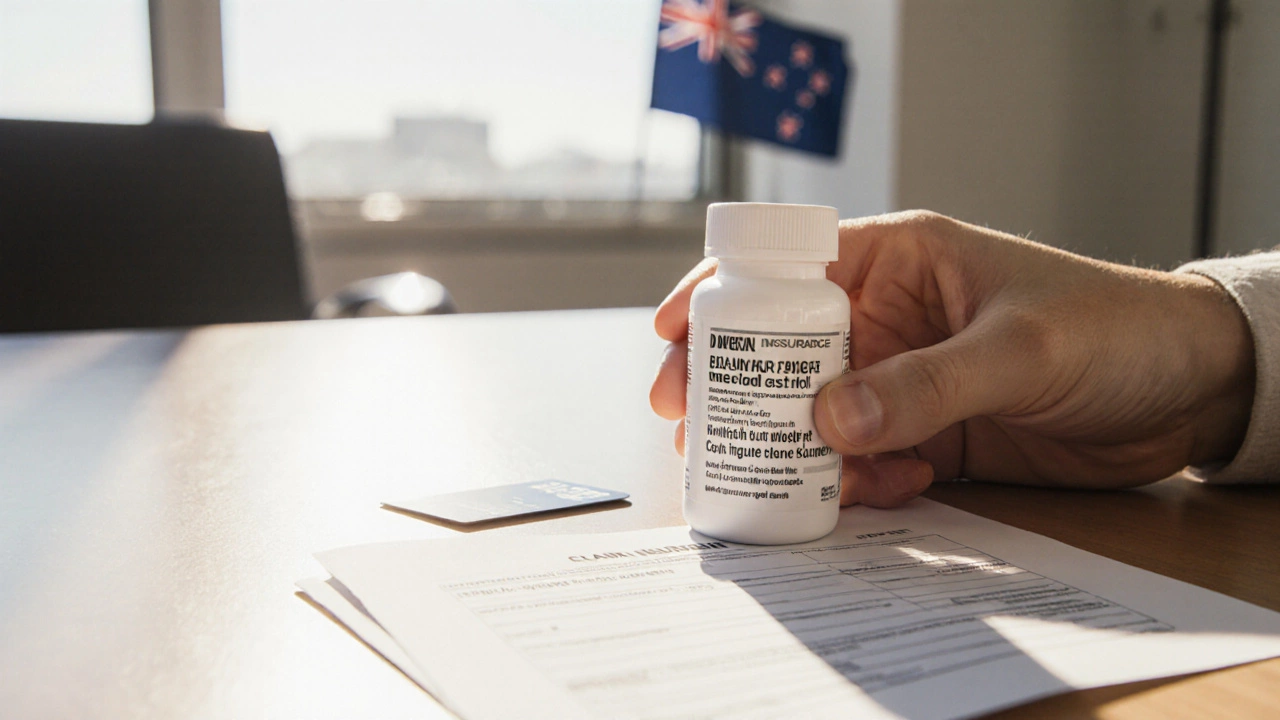
Weight Loss Pill Coverage Checker
Check Your Coverage Eligibility
Enter your details below to see if your prescribed weight loss medication is likely to be covered by insurance.
Coverage Result:
Key Takeaways
- Coverage depends on medical necessity, BMI thresholds, and the specific drug.
- Newer GLP‑1 drugs like Wegovy are rarely covered without strict criteria.
- Older generic options such as Orlistat have a higher chance of partial reimbursement.
- Proper documentation and pre‑authorization are crucial to avoid claim denial.
- If insurance won’t pay, consider lifestyle programs or subsidised options through PHARMAC.
When you see a prescription for a weight loss pill, the first question is often: will my insurance pay for it? The answer isn’t simple because insurers use a mix of clinical guidelines, cost‑effectiveness rules, and individual policy language. This article breaks down the factors that determine coverage, walks you through the steps to get a claim approved, and lists which drugs are most likely to be accepted in New Zealand.
Weight loss pills are prescription medications designed to help people lose body fat by suppressing appetite, increasing satiety, or reducing fat absorption. In New Zealand, the most common classes are orlistat, sympathomimetic agents (like phentermine), and the newer glucagon‑like peptide‑1 (GLP‑1) agonists.
How Insurers Decide Whether to Pay
Insurance companies, whether private or public, base their decisions on three core concepts:
- Medical necessity: The drug must be deemed essential for treating a diagnosed condition, usually obesity with a body‑mass‑index (BMI) above a set threshold.
- Cost‑effectiveness: Agencies such as the Pharmaceutical Management Agency (PHARMAC) evaluate whether the drug provides enough health benefit for its price.
- Policy language: Each health insurance plan outlines which conditions and medications are covered. Look for terms like “obesity management,” “weight‑loss pharmacotherapy,” or “approved bariatric drugs.”
Health insurance in New Zealand includes private plans offered by insurers such as Southern Cross Health Society, nib, and ACC’s injury‑related coverage for certain weight‑loss surgeries. Private insurers typically require a pre‑authorization, while PHARMAC decides on subsidised dispensing for publicly funded prescriptions.
Typical Coverage Criteria
Most policies use the following criteria before they’ll consider reimbursing a weight‑loss pill:
- BMI requirement: Usually a BMI≥30kg/m², or BMI≥27kg/m² with at least one obesity‑related comorbidity (type‑2 diabetes, hypertension, sleep apnoea). BMI is a simple calculation of weight divided by height squared.
- Failed lifestyle intervention: Documentation that the patient has tried at least a 3‑month structured diet and exercise program without adequate results.
- Doctor’s endorsement: A qualified GP or specialist must certify that pharmacotherapy is medically necessary.
- Drug‑specific restrictions: Some insurers only cover generic orlistat; newer GLP‑1 agents may need a specialist’s prescription and a trial of other medicines first.

Which Weight Loss Pills Are Most Likely to Be Covered?
Below is a snapshot of the most common prescription options and how insurers typically view them. The likelihood column reflects the average stance of private insurers and PHARMAC as of 2025.
| Medication | Drug class | Typical cost (NZD per month) | Coverage likelihood | Key restriction |
|---|---|---|---|---|
| Orlistat is a lipase inhibitor that blocks fat absorption. | Orlistat class (generic) | ≈$45 | High (often subsidised) | Must have BMI≥30 |
| Phentermine is a sympathomimetic appetite suppressant. | Sympathomimetic | ≈$70 | Medium (requires pre‑auth) | Limited to 12‑week courses |
| Wegovy (semaglutide) is a GLP‑1 agonist approved for chronic weight management. | GLP‑1 agonist | ≈$300 | Low (often denied unless specialist confirms ≥2 comorbidities) | Must have tried ≥2 other agents |
| Saxenda (liraglutide) is another GLP‑1 agonist, originally for diabetes. | GLP‑1 agonist | ≈$250 | Low (specialist sign‑off needed) | Same as Wegovy |
Step‑by‑Step Guide to Getting Your Prescription Paid
Follow these actions to maximise the chance that your claim gets approved:
- Get a proper assessment: Book an appointment with your GP. Bring recent weight records, BMI calculation, and a log of diet/exercise attempts.
- Ask for a written medical necessity statement: The doctor should note the BMI, any comorbidities, and why lifestyle changes haven’t worked.
- Request a pre‑authorization form: Most insurers require you to submit a specific form before dispensing. The form will ask for the medication name, dosage, and expected duration.
- Submit supporting documents: Include blood‑test results, blood‑pressure readings, and any specialist letters if you have them.
- Follow up: Call the insurer’s pharmacy benefit manager after 5‑7days to confirm receipt and ask for an estimated decision time.
- If denied, appeal: Gather additional evidence (e.g., a second doctor’s opinion) and file an internal appeal. Many successful appeals reference PHARMAC’s public cost‑effectiveness reports.
Common Reasons Claims Get Denied (And How to Fix Them)
Denials often stem from missing paperwork or not meeting the insurer’s criteria. Here are the top three and quick fixes:
- Missing BMI proof: Provide a recent clinic letter that lists height, weight, and calculated BMI.
- Insufficient lifestyle documentation: Submit a signed statement from a dietitian or a gym log covering at least the past three months.
- Drug‑specific exclusion: If the insurer excludes GLP‑1 agents, ask your doctor to consider a trial of an approved generic first.

Alternative Paths When Insurance Won’t Pay
If you hit a wall, there are still options for managing weight without breaking the bank:
- PHARMAC‑subsidised programs: Occasionally, PHARMAC adds a weight‑loss medication to its subsidised list after a public health review. Keep an eye on the agency’s quarterly announcements.
- Private discount cards: Some pharmacies offer discount cards that cut the price of brand‑name GLP‑1 drugs by up to 30%.
- Clinical trials: Universities in Auckland and Wellington run trials for new obesity drugs. Participants often receive the medication for free.
- Bariatric surgery coverage: If pharmacotherapy fails, insurers may cover sleeve gastrectomy or gastric bypass when BMI≥35kg/m² with comorbidities. Surgery can be more cost‑effective in the long run.
What to Expect After Approval
Once your claim is approved, the pharmacy will dispense the medication and bill the insurer directly. You’ll receive a statement showing any co‑pay (usually 10‑20% of the drug’s cost). Keep all receipts in case the insurer later requests proof of payment.
Frequently Asked Questions
Do private health insurers in New Zealand cover Orlistat?
Yes, most private plans cover Orlistat when the patient meets the BMI≥30kg/m² threshold and has documented attempts at diet and exercise. The claim usually requires a simple GP prescription and a pre‑authorization form.
Why are GLP‑1 drugs like Wegovy rarely reimbursed?
GLP‑1 agents are expensive (around $300 per month) and are considered “high‑cost” medicines. PHARMAC and private insurers require strict clinical criteria-usually a BMI≥35kg/m² plus two obesity‑related comorbidities-and evidence that other, cheaper medications have failed.
Can I appeal a denial for a weight‑loss prescription?
Absolutely. Gather additional medical records, a second specialist opinion, and any relevant PHARMAC cost‑effectiveness reports. Submit the appeal within the timeframe indicated on the denial letter (usually 30days).
Is bariatric surgery covered if medication isn’t approved?
Many insurers cover bariatric surgery for patients with BMI≥35kg/m² plus at least one serious comorbidity, or BMI≥40kg/m² on its own. You’ll need a comprehensive specialist report and usually a mandated diet‑and‑exercise trial before surgery is approved.
How often can I request a pre‑authorization?
Pre‑authorizations are typically valid for a 3‑month supply. If you need a refill beyond that period, you must submit a new request with updated medical notes.
Categories
Popular Articles

Jan 24 2025

Apr 1 2025



